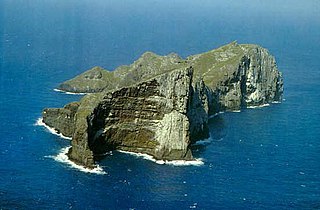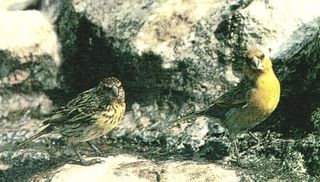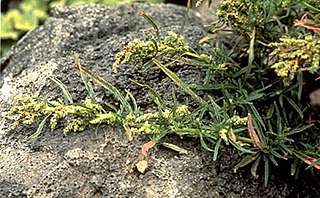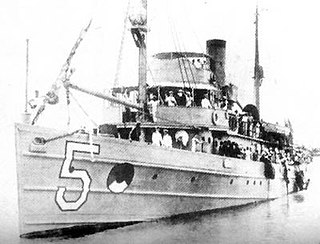
Necker Island, in Hawaiian Mokumanamana, is a small island in the Northwestern Hawaiian Islands. It is located at 23°34′30″N164°42′01″W in the Pacific Ocean, 430 miles northwest of Honolulu, Hawaii, 155 miles northwest of Nihoa, and 8 miles north of the Tropic of Cancer. It is part of the State of Hawaii in the United States. It contains important prehistoric archaeological sites of the Hawaiian culture and is part of the Hawaiian Islands National Wildlife Refuge within the Papahānaumokuākea Marine National Monument.

Nihoa, also known as Bird Island or Moku Manu, is the tallest of ten islands and atolls in the uninhabited Northwestern Hawaiian Islands (NWHI). The island is located at the southern end of the NWHI chain, 296 km (160 nmi) southeast of Necker Island. Nihoa is the closest NWHI in proximity to the eight main windward Hawaiian Islands at approximately 240 km (130 nmi) northwest of the island of Kauaʻi. The island has two peaks, 272 m (892 ft) Miller's Peak in the west, and 259 m (850 ft) Tanager Peak in the east. Nihoa's area is about 171 acres (0.69 km2) and is surrounded by a 142,000-acre (57,000 ha) coral reef. Its jagged outline gives the island its name, Nīhoa, which is Hawaiian for "tooth".

The Northwestern Hawaiian Islands or Leeward Islands are the small islands and atolls in the Hawaiian island chain located northwest of the islands of Kauai and Niihau. Politically, they are all part of Honolulu County in the U.S. state of Hawaii, except Midway Atoll, which is a territory distinct from the State of Hawaii, and grouped as one of the United States Minor Outlying Islands. The United States Census Bureau defines this area, except Midway, as Census Tract 114.98 of Honolulu County. Its total land area is 3.1075 square miles (8.048 km2). All the islands except Nihoa are north of the Tropic of Cancer, making them the only islands in Hawaii that lie outside the tropics.

Laysan, located 808 nautical miles northwest of Honolulu at 25°42′14″N171°44′04″W, is one of the Northwestern Hawaiian Islands. It comprises one land mass of 1,016 acres (4.11 km2), about 1 by 1+1⁄2 miles in size. It is an atoll of sorts, although the land completely surrounds a shallow central lake some 8 feet (2.4 m) above sea level that has a salinity approximately three times greater than the ocean. Laysan's Hawaiian name, Kauō, means egg.

The Laysan finch is a species of Hawaiian honeycreeper, that is endemic to the Northwestern Hawaiian Islands. It is one of four remaining finch-billed Hawaiian honeycreepers and is closely related to the smaller Nihoa finch. The Laysan finch is named for Laysan, the island to which it was endemic on its discovery. It was subsequently introduced to a few other atolls, and its historical range included some of the main islands.

The Nihoa finch is one of the two endemic bird species of the tiny Hawaiian island Nihoa, the other being the Nihoa millerbird. When it was classified in 1917, scientists thought that it would be the last endemic species named. This was later found untrue. The island's population is 1000–3000 birds. The Nihoa finch was added to the Endangered Species List by the U.S. Fish and Wildlife Service on March 11, 1967. An attempt to protect the species against extinction was made by starting a colony on French Frigate Shoals, another leeward island. This would ensure its continued existence in case the Nihoa population was wiped out. This attempt, however, failed. Nihoa is part of a group of islands that make up the Hawaiian Islands National Wildlife Refuge which provides protected land for the Nihoa finch to roam on.

The poʻo-uli, or black-faced honeycreeper, is an extinct species of passerine bird that was endemic to the island of Maui in Hawaiʻi. It is considered to be a member of the Hawaiian honeycreepers, and is the only member of its genus Melamprosops. It had a black head, brown upper parts and pale gray underparts. This bird inhabited only the wetter, easternmost side of Maui, where it had rapidly decreased in numbers. With extinction threatening, efforts were made to capture birds to enable them to breed in captivity. These efforts were unsuccessful; in 2004, only two known birds remained, and since then, no further birds have been sighted. A 2018 study recommended declaring the species extinct, citing bird population decline patterns and the lack of any confirmed sightings since 2004, and in 2019, the species was declared extinct.

Pritchardia remota, the Nihoa pritchardia, Nihoa fan palm, or Loulu, is a species of palm endemic on the island of Nihoa, Hawaiʻi, and later transplanted to the island of Laysan. It is a smaller tree than most other species of Pritchardia, typically reaching only 4–5 metres (13–16 ft) tall and with a trunk diameter of 15 centimetres (5.9 in). It is the only type of tree on the island and used to be abundant. In 1885 a wildfire ravaged the island, destroying most of the palms. Only about 700 of these trees remain, making the species endangered but numbers are slowly increasing. The palm is being cultivated in botanical gardens.

Schiedea verticillata, known as the Devils Slide schiedea or Nihoa carnation, is an endangered species of plant in the family Caryophyllaceae, endemic to the island of Nihoa in the Northwestern Hawaiian Islands, where it was discovered in 1923 by the Tanager Expedition. It has been listed as endangered since 1996.

The Papahānaumokuākea Marine National Monument is a World Heritage listed U.S. National Monument encompassing 583,000 square miles (1,510,000 km2) of ocean waters, including ten islands and atolls of the Northwestern Hawaiian Islands. Created in June 2006 with 140,000 square miles (360,000 km2), it was expanded in August 2016 by moving its border to the limit of the exclusive economic zone, making it one of the world's largest protected areas. It is internationally known for its cultural and natural values as follows:
The area has deep cosmological and traditional significance for living Native Hawaiian culture, as an ancestral environment, as an embodiment of the Hawaiian concept of kinship between people and the natural world, and as the place where it is believed that life originates and to where the spirits return after death. On two of the islands, Nihoa and Mokumanamana, there are archaeological remains relating to pre-European settlement and use. Much of the monument is made up of pelagic and deepwater habitats, with notable features such as seamounts and submerged banks, extensive coral reefs and lagoons.

Amaranthus brownii was an annual herb in the family Amaranthaceae. The plant was found only on the small island of Nihoa in the Northwestern Hawaiian Islands, growing on rocky outcrops at altitudes of 120–215 m (394–705 ft). It was one of nine species of Amaranthus in the Hawaiian Islands, as well as the only endemic Hawaiian species of the genus. It is now considered extinct.

Thaumatogryllus conanti is a nocturnal species of cricket endemic to the island of Nihoa, where it is found in Devil's Slide, a narrow ravine. It is named after Dr. Sheila Conant, the scientist who discovered it in the 1980s. Including T. conanti, there are only four known species in the genus Thaumatogryllus, which is endemic to Hawaii. Another species is found only in lava tubes on the Island of Hawaii.

The Nihoa trapdoor spider or Nihoa mahina is a trapdoor spider endemic to Nihoa, Hawaii. These spiders are hunters that dig a hole near rocks cover it with a concealed trapdoor. These burrows are excavated completely with the spider's jaw. When prey approaches or falls in, the spider pounces on it. Then its abnormally large pedipalps are used to take food into the mouth.

The TanagerExpedition was a series of five biological surveys of the Northwestern Hawaiian Islands conducted in partnership between the Bureau of Biological Survey and the Bishop Museum, with the assistance of the United States Navy. Four expeditions occurred from April to August 1923, and a fifth in July 1924. Led by Lieutenant Commander Samuel Wilder King on the minesweeper USS Tanager (AM-5), and Alexander Wetmore directing the team of scientists, the expedition studied the plant animal life, and geology of the central Pacific islands. Noted members of the team include archaeologist Kenneth Emory and herpetologist Chapman Grant.

The Hawaiian coot, also known as the ʻalae kea in Hawaiian, is a bird in the rail family, Rallidae, that is endemic to Hawaiʻi. In Hawaiian, ʻalae is a noun and means mud hen. Kea or its synonym keo is an adjective for white. It is similar to the American coot at 33–40.6 cm (13–16 in) in length and weighing around 700 g. It has black plumage and a prominent white frontal shield. Its natural habitats are freshwater lakes, freshwater marshes, coastal saline lagoons, and water storage areas. The bird was federally listed in October 1970 as an endangered species and is considered both endemic and endangered by the state of Hawaii. It is threatened by habitat loss and introduced predators such as the small Asian mongoose. The Makalawena Marsh on the Big Island of Hawaiʻi has been listed as a National Natural Landmark to preserve one of its last nesting areas.
Belocephalus sleighti, known as the Keys short-winged conehead katydid, is a species of katydid that is endemic to the United States.

The Northwestern Hawaii scrub is a tropical and subtropical grasslands, savannas, and shrublands ecoregion on the Northwestern Hawaiian Islands in the Pacific Ocean.
















